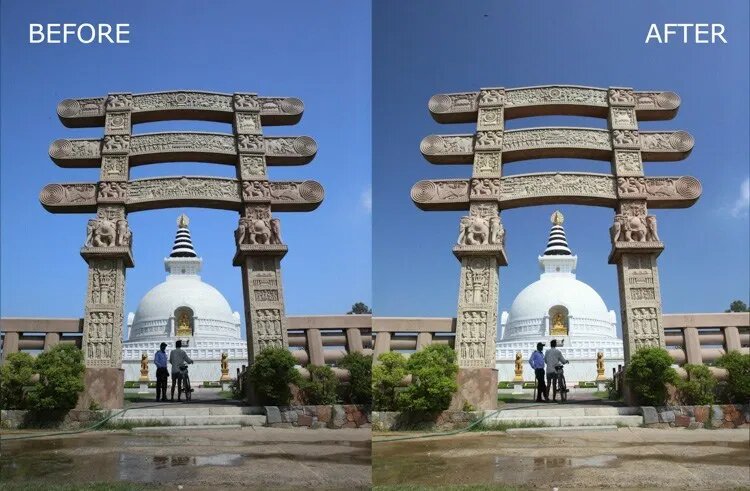Using various filters to enhance photographs is only one of the many things that set professional photographers apart from average Joe. A CPL (Circular Polarizing Filter) is the most inventive way to improve the final image that appears on your camera’s LCD screen among the numerous filters. A CPL Filter will assist you in getting the best shot if you are an outdoor photographer who takes pictures of varied landscapes.
The reason polarizing filters are so named is not that they divide ideas about their usefulness but rather because of how well they manage the light entering the lens. The most popular filter today is circular, which means that every filter’s initial filter is linear and works better with modern focusing systems.
What Is CPL Filter?
Photographers of landscapes are renowned for their use of circular polarizing filters (CPL). A lens accessory called a CPL filter attaches to the side of your camera lens that faces outward. The best camera accessory for a landscape photographer is a CPL since it enables you to capture images with contrast and brightness. It helps to reduce reflections, darken more vivid skies, and eliminate water’s sheen.
A direct polarizer is the first step of a circular polarizing filter (CPL), which flips the balance of the light in the image. With the help of these lens filters, you may capture translucent water, deep, beautiful skies, and less reflection and glare. You may take better-looking photos by reducing reflection with a circular polarizing filter (CPL). A CPL filter will restore clarity to the water.
How Does A CPL Filter Work?
If you’re working on a trip project or in a national park, you may want to consider using a circular polarizing filter to improve the clarity of your photos. When photographing vistas or landscapes, a circular polarizing filter (CPL) reduces or eliminates glare, reflections, and overexposure.
To utilize the circular polarizing filter effectively, you’ll need to practice a lot. Finding the correct filter to match your lens won’t be a difficult task for novices because the filters themselves are typically available in a range of diameters. All non-metallic objects have the potential to reflect and return light that can be split, attracting unwanted attention.
Once connected, move the filter to achieve the desired effect. NF can produce the same results (neutral density filters). The widespread consensus is that the best results are produced when the lens is pointed towards your source at a 90-degree angle. There are several situations where using a CPL properly can have magical effects.
When Taking Blue Sky Photos:
Make sure the lenses and all the filters are up to date and clean. The camera must be turned 90 degrees away from the sun. If you are photographing directly into or against the sun, the circular polarizing filter will not work. Take numerous photos with differing polarization levels so that you have more options for post-processing.
When It Is Dark Or There Is No Sun:
By shifting the opposing ring, the CPL filter eliminates the replications where the water originates in plants and pebbles. It will give you access to a completely new level of knowledge that was hidden beneath the mirrors. This effect cannot be produced without the CPL filter. It doesn’t matter if you capture it directly into the sun because there is no reason to be afraid of it.
Principal Results of CPL Filter:
Replications from metal surfaces can be removed using a circular polarizer filter (CPL filter). You must test the polarizing filter because metal and timber coatings scatter light. It is challenging to blacken the sky and separate the light at sunrise and sunset. The sky will change into a deep blue with an elevation toward the horizon.
The shade might become saturated using a circular polarizer filter. By removing reflections and using a light filter, this appearance is achieved. Additionally, it removes the white or dazzling light that emanates from the leaves and imparts a gorgeous, consistent shade of green. This can be done once more under deep blue skies, although it will intensify the leaf’s green hue.
Important Advice for Using the CPL Filter:
If you decide on a sunny day, place your subject on your shoulder and your shoulder on the right side of the sun.
- The impact of the circular polarizer filter is influenced by the direction of light and the sky’s cast of shadows.
- A particular quantity of underexposure will be produced by a circular polarizer filter.
- The ISO must be increased from 100 to 380 or 400.
- Measure the saturation, contrast, and reflection levels after rotating the CPL filter 360 degrees. There are only two options: rising or decreasing, and the degree at which you want to search for photographs.
- Any filter used in addition to CPL will make the igniting effect worse.
- If you’re using a wide-angle lens to photograph the sky, you must cease using CPL. The result is so diverse throughout the entire sky that it loses all impact and emphasis.
- When attempting to photograph a rainbow on an overcast day, circular polarizer filters will have little to no effect.
Benefits of the CPL Filter
- A circular polarizing filter could make the sky appear darker. You’ll have a sharper vision of far-off objects, and they will appear darker and wealthier.
- The deep component in your frame may generate a mirror image, which the CPL filter may help to decrease.
- The CPL filter eliminates reflections from shiny objects like metals, glass, or sand beaches, resulting in photographs that are stronger, clearer, and brighter.
- By utilizing the Circular Polarizing Filter, you can make the sky and other elements of your frame more colorful (CPL).
- Surfaces like leaves or walls reflect light in a way that makes the colors appear rich, and the shadows appear dark.
Final Verdict:
A lens accessory known as a circular polarizing filter can reduce glare from reflected objects. A circular polarizing filter (CPL) could give your photos a striking appearance. Your landscape photography will require professional photo quality, and reflections and tints will appear best and most natural. You can find a detailed guide to the CPL (Circular Polarizing Filter) filter right here.







Discussion about this post